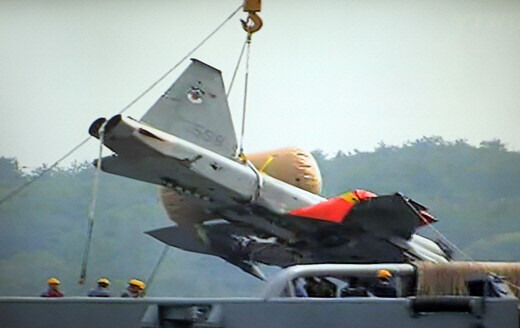hankyoreh
Links to other country sites 다른 나라 사이트 링크
Fighter plane crashes underline need for accident prevention

The Friday crash of an Air Force F-5F fighter plane into the East Sea brings the total of fighter accidents since 2000 up to 20, with 24 aircrafts lost. This means an average of two crashes take place every year. During the past ten years, the equivalent of one fighter plane squadron, which consists of around twenty aircraft, has disappeared in peacetime accidents.
The Air Force F-5 fighter in particular has earned an accident-prone reputation, as ten have crashed since 2000. On March 2, an F-5E and F-5F crashed in Pyeongchang, Gangwon Province. Now, three months later, another accident has occurred with the same model.
As a reason for the conspicuous frequency of F-5 accidents, military authorities have cited the fact that it is an old model introduced between 24 and 36 years ago. This means that the F-5s are at or past the end of their 30-year lifespan.
Military authorities explain that the reason the F-5 fighters have not been retired is because they are needed to maintain a deterrent against North Korea. Indeed, the roughly 170 planes of this model account for 35 percent of the Air Force’s entire fighter plane fleet. Because of this, the Air Force plans to use these fighters through the latter part of the 2010s, carrying out performance improvement efforts, rather than retiring them all at once.
In 2001, the Ministry of National Defense set as a national project the Korean-model KTX stealth fighter to replace fighter planes that had passed their retirement date, including the F-5 and F-4. However, the project has been delayed due to budget and technology issues. “It is difficult to obtain parts for the F-5, so the parts have been secured by taking parts from the same model of fighter and attaching them to others,” explained a military official.
However, the recent string of crashes among similar types of Air Force fighters has led observers to question whether military authorities have taken too passive of an approach to accident prevention and dwelling excessively on budget issues. Military authorities said there appeared to be no airframe damage to the fighter that crashed on Friday. But if it is discovered that the accident resulted from human error, such as poor maintenance, those authorities will have a hard time dodging criticisms.
Experts noted the need for active efforts by military authorities to establish accident prevention measures, given the loss of life, economic damages and security burden caused by the fighter crashes. Based on accounts from the Air Force, it costs 9 billion Won ($7.6 million) over ten years to train KF-16 pilots, around 4.2 billion Won to train F-5 pilots, and around 7.5 billion Won for the F-4 model. Totaling all of the training expenses for the 20 pilots who have lost their lives over the past decade, taking into account the different models of plane, results in an overall 105 billion Won. Factoring the cost of the planes themselves into the equation gives a loss of more than 560 billion Won. With an increase trend of experienced pilots moving into civil aviation, observers have begun to call for special accident prevention measures.
Please direct questions or comments to [englishhani@hani.co.kr]
Editorial・opinion
![[Editorial] Penalties for airing allegations against Korea’s first lady endanger free press [Editorial] Penalties for airing allegations against Korea’s first lady endanger free press](https://flexible.img.hani.co.kr/flexible/normal/500/300/imgdb/original/2024/0502/1817146398095106.jpg) [Editorial] Penalties for airing allegations against Korea’s first lady endanger free press
[Editorial] Penalties for airing allegations against Korea’s first lady endanger free press![[Editorial] Yoon must halt procurement of SM-3 interceptor missiles [Editorial] Yoon must halt procurement of SM-3 interceptor missiles](https://flexible.img.hani.co.kr/flexible/normal/500/300/imgdb/child/2024/0501/17145495551605_1717145495195344.jpg) [Editorial] Yoon must halt procurement of SM-3 interceptor missiles
[Editorial] Yoon must halt procurement of SM-3 interceptor missiles- [Guest essay] Maybe Korea’s rapid population decline is an opportunity, not a crisis
- [Column] Can Yoon steer diplomacy with Russia, China back on track?
- [Column] Season 2 of special prosecutor probe may be coming to Korea soon
- [Column] Park Geun-hye déjà vu in Yoon Suk-yeol
- [Editorial] New weight of N. Korea’s nuclear threats makes dialogue all the more urgent
- [Guest essay] The real reason Korea’s new right wants to dub Rhee a founding father
- [Column] ‘Choson’: Is it time we start referring to N. Korea in its own terms?
- [Editorial] Japan’s rewriting of history with Korea has gone too far
Most viewed articles
- 11 in 3 S. Korean security experts support nuclear armament, CSIS finds
- 2Months and months of overdue wages are pushing migrant workers in Korea into debt
- 3Bills for Itaewon crush inquiry, special counsel probe into Marine’s death pass National Assembly
- 4Trump asks why US would defend Korea, hints at hiking Seoul’s defense cost burden
- 5[Reporter’s notebook] In Min’s world, she’s the artist — and NewJeans is her art
- 6[Editorial] Penalties for airing allegations against Korea’s first lady endanger free press
- 7S. Korea discusses participation in defense development with AUKUS alliance
- 8[Column] Can Yoon steer diplomacy with Russia, China back on track?
- 9Vietnamese war victims speak of sexual violence by S. Korean troops for the first time
- 1060% of young Koreans see no need to have kids after marriage